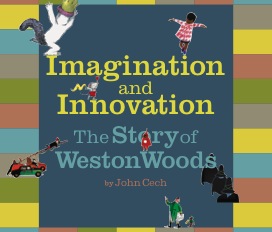Imagination and Innovation, The Story of Weston Woods. New York: Scholastic Press, Fall 2009.

From the Jacket Cover:
For more than a half century, Weston Woods has been regarded as the leading creative force in the production of films for children. The list of the authors and artists whose works have transformed from books into films by the studio includes many of the most significant figures in modern children’s literature — from Robert McCloskey, William Steig, and Maurice Sendak to Margaret Mahy, Sims Taback, Rosemary Wells, and Mo Willems.
In this lush nonfiction volume — rich with archival photographs, animation cells, historical references, and first-person accounts, readers get a personal, behind-the-scenes look at the man and creative empire who have garnered nearly ever award for distinguished productions in the field of children’s media.
Angels and Wild Things: The Archetypal Poetics of Maurice Sendak. University Park: Penn State Press, 1995.

Book Description (from amazon.com)
Over the course of more than 80 books that he has written and illustrated in a career that has spanned four decades, Maurice Sendak has become an influential and controversial creator of works for children. Each of the books in his trilogy – “Where the Wild Things Are”, “In the Night Kitchen” and “Outside Over there” – has been precedent-setting, dramatically expanding the boundaries of subject matter and images that have been conventionally accepted in books for younger children. In this first comprehensive reading of Sendak’s key works, John Cech considers the symbolic child who has appeared and developed in Sendak’s books and remains at the centre of his vision. By fusing biographical, historical, cultural and literary materials with the insights of depth psychology and archetypal theory, this study traces the evolution of Sendak’s work – from its first, bold steps in the 1950s, to its liberating breakthroughs of the 1960s and early 1970s, to the rich complexity of his most recent books. Though touching on many of the works that Sendak has been involved with, Cech concentrates on those books that Sendak has both written and illustrated. It is in these books that we can see most clearly the poesis of Sendak’s art, the alchemy of his creative process that has woven together the remembrances of his own things past, the spirit of his times, the history of children’s literature, and Sendak’s animating concern with the archetypal figure of the child – a symbol of creative potential, emotional vitality and spiritual renewal.
From Booklist
Although Sendak is one of the few children’s illustrators whose work reaps wide coverage in national newspapers and magazines, his illustrations have not undergone such an intensive exploration since Selma Lane’s Art of Maurice Sendak (1980). Cech delivers a sophisticated analysis that delves into Sendak’s writing and pictures and the rich symbolism of his work, all for the purpose of capturing the “unique Sendakian child.” Focusing on the eight books that Sendak has both written and illustrated, Cech begins with the early robust characters from the Nutshell Library; leads readers through a thought-provoking examination of Max, Mickey, and Ida in Where the Wild Things Are, The Night Kitchen, and Outside over There, respectively; and concludes by discussing the somewhat baffling images in Down in the Dumps with Jack and Guy. Sendak, Cech claims, “takes adults back to their [childhoods] and allows children to fully claim their own.” This fascinating study, which includes a generous supply of black-and-white illustrations, a 12-page inset of full-color reproductions, and a complement of notes, will give students of children’s literature and devotees of Sendak the chance to follow the trail. Barbara Elleman